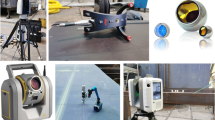Abstract
During industrial forging of hot metallic shells, it is necessary to regularly measure the dimensions of the parts, especially the inner and outer diameters and the thickness of the walls. A forging sequence lasts 2 h or more during which the diameter of the shell is regularly measured in order to decide when to stop the forging process. For better working conditions, for the safety of the blacksmiths, and for a faster and more accurate measurement, we have developed a novel system based on two commercially available time of flight laser scanners for the measurement of the diameters of hot cylindrical metallic shells during the forging process. The advantages of using laser scanners are that they can be placed very far from the hot shell, more than 15 m, while at the same time giving an accurate point cloud from which three-dimensional views of the shell can be reconstructed and diameter measurements done. Moreover, more accurate measurement is achieved in less time with the laser system than with the conventional method using a large ruler. The system has been successfully used to measure the diameters of hot cylindrical metallic shells.
Similar content being viewed by others
References
Xiao, Y., Zhan, Q., Pang, P.: 3D data acquisition by terrestrial laser scanning for protection of historical buildings. In: International Conference on Wireless Communications, Networking and Mobile Computing, 21–25 Sep 2007, pp. 5971–5974 (2007)
Biskup, K., Arias, P., Lorenzo, H., Armesto, J.: Application of terrestrial laser scanning for shipbuilding. In: Proceedings of IAPRS Workshop on Laser Scanning 2007 and SilviLaser 2007, vol. XXXVI, part 3, W52, Espoo, Finland, 12–14 Sep 2007, pp. 56–61 (2007)
Danson F.M., Hetherington D., Morsdorf F., Allgöwer B.: Forest canopy gap fraction from terrestrial laser scanning. IEEE Geosci. Remote Sens. Lett. 4(1), 157–160 (2007)
Gordon, S., Lichti, D., Franke, J., Stewart, M.: Measurement of structural deformation using terrestrial laser scanners. In: Proceedings of 1st FIG International Symposium on Engineering Surveys for Construction Works and Structural Engineering, Nottingham, UK, 28 Jun–1 Jul 2004 (2004)
Tsakiri, M., Lichti, D., Pfeifer, N.: Terrestrial laser scanning for deformation monitoring. In: 3rd IAG/12th FIG Symposium, Baden, 22–24 May 2006 (2006)
Staiger, R.: Laser scanning in an industrial environment. In: Proceedings of FIG XXII International Congress, Washington, DC, 19–26 Apr 2002 (2002)
Mä ättä, K., Kostamovaara, J., Myllylä, R.: On the measurement of hot surfaces by pulsed time-of-flight laser radar techniques. In: Proceedings of SPIE, vol. 1265, Industrial inspection II, 12–13 Mar 1990, pp. 179–191 (1990)
Mä ättä, K., Kostamovaara, J., Myllylä, R.: A laser rangefinder for hot surface profiling measurements. In: Proceedings of SPIE, vol. 952, Laser Technologies in Industry, pp. 356–364 (1988)
Bokhabrine, Y., Lew Yan Voon, L.F.C., Seulin, R., Gorria, P., Gomez, M., Jobard, D.: 3D reconstruction of hot metallic surfaces for industrial part characterization. In: Proceedings of SPIE—Electronic Imaging 2009, SPIE, San Jose, USA, vol. 7251 (2009). doi:10.1117/12.806015
Bokhabrine, Y., Lew Yan Voon, L.F.C., Seulin, R., Gorria, P., Girardin, G., Gomez, M., Jobard, D.: 3D dimensional measurement of large hot metallic shells. In: CD-ROM Proceedings of QCAV 2009, Wels, Austria (2009)
Leica Geosystems: Leica Scanstation 2 Time of Flight Laser Scanner. http://hds.leica-geosystems.com/en/Leica-ScanStation-2_62189.htm
Holland J.H.: Adaptation in Natural and Artificial Systems. MIT Press, Cambridge (1992)
DoCarmo M.P.: Differential Geometry of Curves and Surfaces. Prentice-hall, Englewood Cliffs (1976)
Chaperon, T., Goulette, F.: Extracting cylinders in full 3D data using a random sampling method and the Gaussian image. In: Proceedings of Vision, Modeling and Visualization, University of Stuttgart, Germany, pp. 35–42 (2001)
Schnabel R., Wahl R., Klein R.: Efficient RANSAC for point-cloud shape detection. Comput. Graph. Forum 26(2), 214–226 (2007)
Bolles, R.C., Fischler, M.A.: A RANSAC-based approach to model fitting and its application to finding cylinders in range data. In: Proceeding of the 7th IJCAL, Vancouver, pp. 637–643 (1981)
Besl P.J., McKay N.D.: A method for registration of 3-D shapes. IEEE Trans. Pattern Anal. Mach. Intell. 14(2), 239–256 (1992)
Chen Y., Medioni G.: Object modeling by registration of multiple range images. Int. J. Image Vis. Comput. 10(3), 145–155 (1992)
Shakarji C.M.: Least-squares fitting algorithms of the NIST algorithm testing system. J. Res. Natl. Inst. Stand. Technol. 103, 633 (1998)
Author information
Authors and Affiliations
Corresponding author
Rights and permissions
About this article
Cite this article
Bokhabrine, Y., Seulin, R., Lew Yan Voon, L.F.C. et al. 3D characterization of hot metallic shells during industrial forging. Machine Vision and Applications 23, 417–425 (2012). https://doi.org/10.1007/s00138-010-0297-5
Received:
Revised:
Accepted:
Published:
Issue Date:
DOI: https://doi.org/10.1007/s00138-010-0297-5




